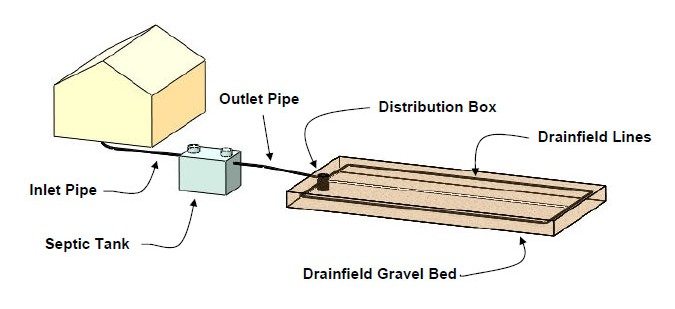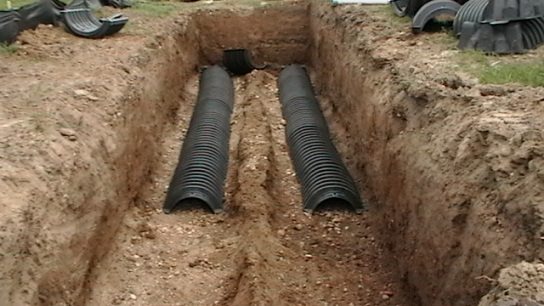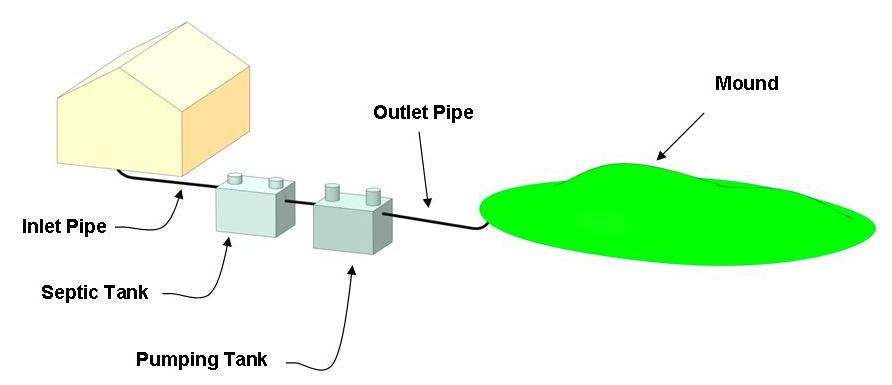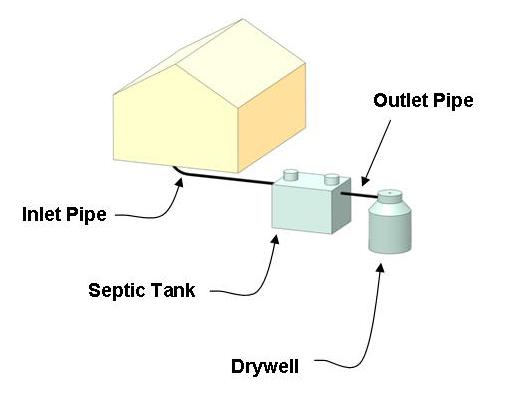There are a few septic system types that dominate the U.S. and Canadian housing and commercial markets. Most contain a septic tank and some type of absorption component. The most common types we have encountered are reviewed below.
Septic Tank and Gravity Fed Drainfield: The most common septic system is the septic tank and gravity fed drainfield. This is a passive system, requiring no auxiliary electrical or mechanical assets to operate. Sewage enters the septic tank via gravity through the inlet pipe. The organic solids in the incoming sewage are broken down into gases and simpler solids by bacteria in the septic tank. Over time, new incoming sewage displaces processed sewage, forcing it via gravity into the outlet pipe and, eventually into the drainfield.

Components of a septic system with a gravity fed drainfield
There are many variations of the gravity fed drainfield. Some are constructed with varying diameters of pipe that is surrounded by crushed stone or gravel. Others are constructed with chambers and no gravel.

Gravity fed drainfield constructed with gravel-less chambers
Septic Tank and Mound: This system operates the same way as the septic tank and gravity fed drainfield with the exception that the treated sewage exiting the septic tank flows into a pumping tank or chamber where it is pumped above the ground level into a mound. The mound contains a series of pipes, sand and soil that allows the water to gradually absorb into the ground.

Septic system containing a mound drainfield
The reason the mound is constructed is that the native ground does not contain adequate permeable soil depth above the water table. The mound, constructed of sand, soil, gravel and drainage pipes above the ground, creates the required permeable soil depth so that the treated water from the septic tank can be distributed and absorbed back into the ground. Not surprisingly, mounds are typically more expensive to install than gravity fed drainfields.

Septic tank and drywell
Septic Tank and Drywell or Seepage Pit: Again, this system functions very similarly to the septic tank and gravity fed drainfield. It is a passive system but contains a drywell instead of a drainfield to allow treated sewage water to be absorbed into the ground. The drywell can be constructed out of a variety of materials and can be surrounded by gravel to aid in the absorption process.
In some areas of the country, septic drywells are constructed to depths of 60 feet or more! Drywells, when allowed by code, are space savers when compared to the gravity fed drainfield or mound.
Conclusion
Regardless of your septic system types, the Aero-Stream remediation system will restore your failed septic system without excavation and save you money!











